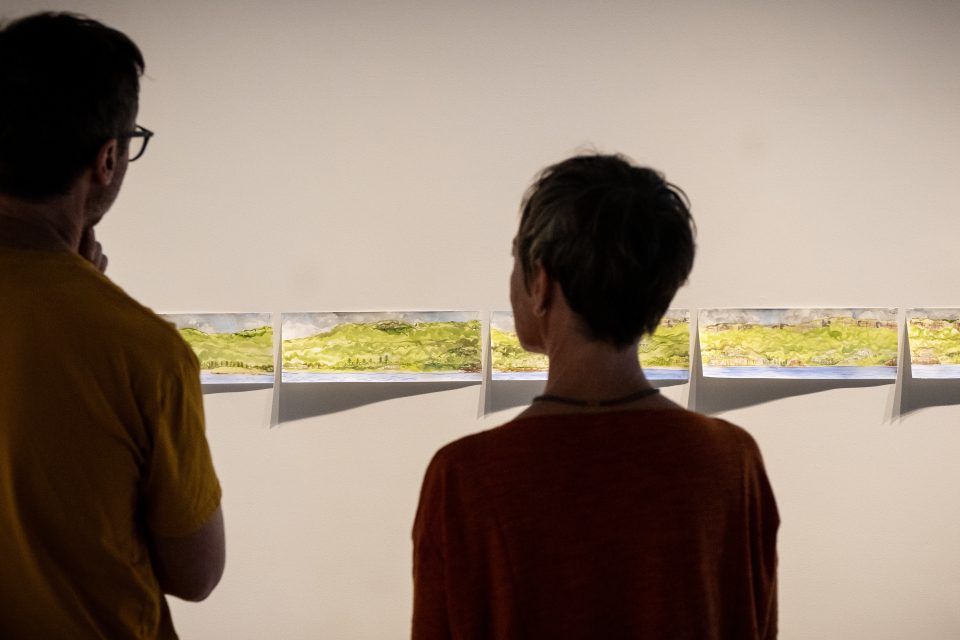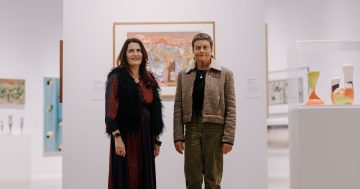
UOW’s Dr Kim Williams, Associate Professor Sarah Hamylton, Associate Professor Leah Gibbs and Dr Lucas Ihlein created and curated the City+Sea exhibition, which quite literally offers a different perspective of the coastal city of Wollongong. Photo: Paul Jones.
From Bald Hill at Stanwell Tops to the Bass Point gravel loader in Shellharbour, visitors to a new exhibition at the University of Wollongong (UOW) are seeing Wollongong’s entire shoreline in a whole new way.
A three-hour and 40-minute video captured in one uninterrupted take by a cinematographer from the viewpoint of a specially chartered fishing boat is part of the City+Sea exhibition, exploring the deep connection between the city of Wollongong and the rugged coastline on which it is built.
A team of four artists, researchers and scientists created and curated the exhibition, including artists Dr Kim Williams and Dr Lucas Ihlein, coastal scientist Associate Professor Sarah Hamylton and human geographer Associate Professor Leah Gibbs, with artistic contributions from Hayden Griffith and Aunty Barbara Nicholson.
Dr Williams said the interdisciplinary approach allowed artists and scientists to use their unique perspectives to raise awareness of looming environmental threats.
“This wasn’t just artists illustrating the ideas of scientists; we worked together on this from the ground up and you get to see what that kind of collaboration brings to a project,” she said.
“The project intended to take an open-ended look at the coastline and not come up with answers but break open questions about what it means to be a city on the sea in the 2020s.”
The exhibition celebrates how the ocean has influenced the evolution of the city, acknowledging its role as more than a scenic backdrop – being a force that underpins the history of Wollongong and informs its future.
Assoc Prof Gibbs said the timing was right for this kind of exhibition, as coastal cities around the world faced rapid social and environmental transformations in the wake of a changing climate.
“We wanted to explore the relationships between the city and the sea and consider what that connection means in a world that is being changed dramatically by sea level rise, climate change and all the social, cultural and political changes that go along with it,” she said.



The video is complemented by a striking, intricate 26-metre-long watercolour artwork created by Dr Williams from sketches feverishly taken from the vessel.
“We sat and watched, and with pieces of paper and pencil drew rudimentary maps of the coastline as we went along, drawing main landforms as we saw them travelling perpendicular to the land, which I later converted into watercolours,” she said.
“That meant we had to observe very closely, and it’s reflected in the video which shows in real time what we were looking at.
“It’s a bit like slow TV. You’re looking at something unremarkable in the sense that there’s no high drama, car chases or gun fights – you’re simply looking at features of the passing landscape, but also the human habitations dotted throughout, which ebbs and flows and, on certain parts of the coastline, is dwarfed by the escarpment. Then you arrive at the steelworks and its industry, industry, industry.”
The result is footage, artworks and texts that entice viewers to slow down, and by extension to connect, according to Assoc Prof Gibbs.
“This is a space for people to come together, to slow down, to yarn, to write, to draw, to create, and to share stories of this place,” she said. “City+Sea is not just about viewing art, but about nurturing our sense of community.”
City+Sea is open daily at UOW Gallery and Foyer, Building 29 from Monday to Wednesday, from 10 am to 4 pm or by appointment until 11 September.










